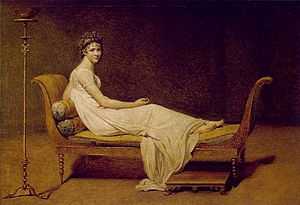Grande Odalisque
 | |
| Artist | Jean Auguste Dominique Ingres |
|---|---|
| Year | 1814 |
| Type | Oil on canvas |
| Dimensions | 88.9 cm × 162.56 cm (35 in × 64 in) |
| Location | Louvre, Paris |
Grande Odalisque, also known as Une Odalisque or La Grande Odalisque, is an oil painting of 1814 by Jean Auguste Dominique Ingres depicting an odalisque, or concubine. Ingres' contemporaries considered the work to signify Ingres' break from Neoclassicism, indicating a shift toward exotic Romanticism.
Grande Odalisque attracted wide criticism when it was first shown. It has been especially noted for the elongated proportions and lack of anatomical realism. The work is displayed in the Louvre, Paris.
History
The painting was commissioned by Napoleon's sister, Queen Caroline Murat of Naples,[1] and finished in 1814. Ingres drew upon works such as Dresden Venus by Giorgione, and Titian's Venus of Urbino as inspiration for his reclining nude figure, though the actual pose of a reclining figure looking back over her shoulder is directly drawn from the 1809 Portrait of Madame Récamier by Jacques-Louis David.

Ingres portrays a concubine in languid pose as seen from behind with distorted proportions. The small head, elongated limbs, and cool color scheme all reveal influences from Mannerists such as Parmigianino,[2] whose Madonna with the Long Neck was also famous for anatomical distortion.
This eclectic mix of styles, combining classical form with Romantic themes, prompted harsh criticism when it was first shown in 1814. Critics viewed Ingres as a rebel against the contemporary style of form and content. When the painting was first shown in the Salon of 1819, one critic remarked that the work had "neither bones nor muscle, neither blood, nor life, nor relief, indeed nothing that constitutes imitation".[3] This echoed the general view that Ingres had disregarded anatomical realism.[4] Ingres instead favored long lines to convey curvature and sensuality, as well as abundant, even light to tone down the volume.[4] Ingres continued to be criticized for his work until the mid-1820s.[2]
Anatomy
Stemming from the initial criticism the painting received, the figure in Grande Odalisque is thought to be drawn with "two or three vertebrae too many."[1][5] Critics at the time believed the elongations to be errors on the part of Ingres, but recent studies show the elongations to have been deliberate distortions.[6] Measurements taken on the proportions of real women showed that Ingres's figure was drawn with a curvature of the spine and rotation of the pelvis impossible to replicate.[5] It also showed the left arm of the odalisque is shorter than the right. The study concluded that the figure was longer by five instead of two or three vertebrae and that the excess affected the lengths of the pelvis and lower back instead of merely the lumbar region.[5]
Another interpretation of this painting suggests that since the duty of some concubines was merely to satisfy the carnal pleasures of the sultan, this elongation of her pelvic area may have been a symbolic distortion by Ingres. While this may represent sensuous feminine beauty, her gaze, on the other hand, has been said to "[reflect] a complex psychological make-up" or "[betray] no feeling". In addition, the distance between her gaze and her pelvic region may be a physical representation of the depth of thought and complex emotions of a woman's thoughts and feelings.[5]
References
- ↑ 1.0 1.1 Weston, Helen (1996). "A Look Back on Ingres". Oxford Art Journal 19 (2): 114–116. doi:10.1093/oaj/19.2.114.
- ↑ 2.0 2.1 Kleiner, Fred; Christian J. Mamiya (2005). Gardner’s Art Through the Ages (12 ed.). California: Wadsworth/Thompson Learning. pp. 826–827. ISBN 0-534-64091-5.
- ↑ Benjamin, Roger (December 2000). "Ingres Chez Les Fauves". Art History 23 (5): 754–755. doi:10.1111/1467-8365.00242.
- ↑ 4.0 4.1 "Une Odalisque". Louvre Museum. Retrieved 2008-01-09.
- ↑ 5.0 5.1 5.2 5.3 Maigne, Jean-Yves; Gilles Chatellier; Hélène Norlöff (July 2004). "Extra vertebrae in Ingres' La Grande Odalisque". Journal of the Royal Society of Medicine 97 (7): 342–344. doi:10.1258/jrsm.97.7.342. PMC 1079534. PMID 15229267. Retrieved 2008-01-09.
- ↑ Hautefeuille, Annie (2 July 2004). "Little extra out the back". The Australian. p. 16.
External links
|
|
![]() Media related to La Grande Odalisque at Wikimedia Commons
Media related to La Grande Odalisque at Wikimedia Commons
| ||||||||||||
_-_Zelfportret_(1864)_-_28-02-2010_13-37-05.jpg)